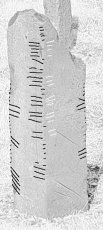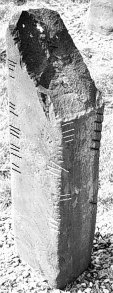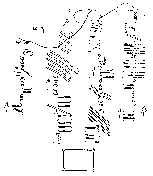The name of the townland is pronounced "more like Kilhullicaha" in the "local pronunciation" according to Macalister, CIIC I, 200 n. 1; according to Epig. 2, 95, "the place is frequently called Kiloolaght .. by the natives".
According to Macalister, CIIC, "a group of stones and fragments" was found on this townland in a field that "is left of an ancient burial ground"; Macalister quotes from "Hitchcocks notebook" that the "broken condition of these memorials" is due to the fact that they were used as "building material" for "a house in the neighbourhood, which in consequence of the sacrilege was uninhabitable". A similar story and some other traditional beliefs (including the existence of a small church) were told to Brash (OIM, 229), according to whom there were no "traces of interments", however. Ferguson asked, "why should the remains of these Qrigifics and Rittufics be deemed unworthy to mingle with baptised clay?" (OI, 106).
According to Brash, the site was visited several times by Windele, and once (at least) by himself, on Aug. 26, 1869.
A sign post which has been set up by the ordnance survey at the site reports that "one stone" was stolen "some years ago"; for this cf. no. {208}. It is not clear at all, however, how many stones there were originally: reports differ between seven and eight.
Size of the present stone according to Macalister, CIIC: 2'11" x 0'9" x 0' 7 1/2".
Published illustrations:
- Brash, OIM pl. XXXI, no. 1 (draft);
- Macalister, Epig. 2, 97 (draft showing three sides);
- Macalister, CIIC 1, 201.
The present stone obviously contains two separate inscriptions.
First angle and opposite:
DANýGNýGORRMAQI | ELIDMES
"DANGORR SON OF ELIDAM".
The last name could "rather" be read as ELIDAMES. Dangorr reminds of Donncoirche, Ann. 4 Mas., AD 787; Elidam reminds of "Elim, AD 56, 76, and Eledach, AD 733".
Third and fourth angles:
ANMFIRFANNITIGIRN
"RESTS THE CHIEF FIRFANN".
"The first seven characters are on the third angle". Firfann is a name not known otherwise, while the element Fir- is frequent. TIGIRN is "an archaic form of Tigearna, Tighearna, a lord or chief"; cp. Tigurn {297: Seskinan} and Mochtigearn, Luchtigearn, Caeltighearn, Faeltigearn in "our indices", Vortigern, Kentigern as "Pseudo-British forms".
Reading Ferguson (105: 175.):
"South" face:
QRIGIFIQQ
This might be "read reversely" as NNITIGERN; but cp. "the CATTUFIQ [{250: Corkaboy} or {184: Gortnagullenagh}] and KELLUFIC [where?] type".
Opposite angle:
SIGANüGNüGe/iLMARI
This has the "appearance of that kind of double reading" as the inscription from Mount Music {135}. - Possibly it was "intended .. to yield the name Mari.
"North" face:
anm vir ....
"The remainder is to me illegible".
"The lines of writing have first to be considered independently":
Angle A (upwards):
íåãèåãìïåãéèæææææ
TELEDMEVv
A downward reading is equally possible, yielding T]TEMLEDEV. In his preliminaries to the present stone, Macalister quoted several inscriptions that allow for a double interpretation like this, viz. {250}, {124}, {189}, {30}, and {265} and the "Mount Callan inscription" {52a}.
Angle B (upwards):
îìåãìâííãîíâïâîíåäìæææ
CEDATTOQAMAQID
The scriber "blocked out all his side scores (except those of the c and of the two d's) on the B-side". The "false scores are fainter than the true digits." A downward reading "gives equally good sense and less bizarre names: ]lin/qa maq Ott/vvales . - [p. 99, n. 1:] The attempt of analyzing CEDATTOQA as [ma]qi-Dattoq is "inadmissible".
Angle C (upwards):
îíòñåäðåäéåäîíîíâæææææ
QRIGIVIQQA
Downward reading: ]anni tigirn .
Angle D (upward):
âêéïéåäòñéæææææ
ANMVIRv/n
Downward reading:
q/trit m(a)q(i).
"The writing is probably boustrophedon, though not necessarily so. .. The determination of the direction of reading .. becomes a matter of trial and error. .. but one sequence is possible that will link all four lines together: this is Cedattoqa maqi D[..] nni tigirn [maq]-Rit-maqi Teledmevv[i]. .. It is .. hopeless to fill the gap between the D and the anni"; names such "as Dolanni or Davanni would satisfy the requirements". - [ib., p. 100, n. 1:] "The stone may possibly .. have two independent inscriptions" like the one at Kilbonane {241}. Anm Vir ...anni tigirn is "feasible", but Cedattoqa maqi D...ttemledev "gives a very uncouth second name". - For "the word tigirn" cp. the stones at Ballyhank {97} or Kilgobnet {214} as well as Seskinan {297}; "it is Proto-Celtic tegernos, Irish tigern, Welsh teyrn `a lord or chief'."
"All four angles are inscribed .. they pair off into two groups, AB and CD, each forming an independent inscription":
First inscription, AB (up-down):
ANM VIRR[...]ANNI TIGIRN
This inscription is written "in boldly cut scores". The "H-Halves of 2R1234, and the whole of" 2R5 "are broken away".
Second inscription: CD (up-up):
CEDATTOQA MAQI VEDELMET[T]
This inscription is written in "more finely cut scores". 4T23 and "anything that followed it are broken off". The reading VEDELMETT is supported by "its identity with the familiar name Feidlimid, although it is written with "side-scores .. interchanged" as TELEDMEVVI. A corrector transferred all H-scores on the C-edge to the B-side, upto 1T; but MAQI "at the top of the line" indicates the correct direction of reading. Brash misread this as `DAžžORR' and was careless "in omitting the initial CE, doubling the R, and reversing the order of the inscribed angles in his drawing".
(i): ANM VIRR.... ANNI TIGIRN
(ii): ...CEDDATOQA MAQI VEDELMET(T
a.: ANM VIRùR[1/2]ANNI TIGIRN
b.: CEDATTOQA MAQI VEDELMETùT[...
The two inscriptions are independent one from each other. In the first one, a sequence of vowel + consonant must have been present, but all conjectures are hpyothetical. The second inscription could also have been longer originally. Considering the writing technique, the second inscription seems to be later than the first one, but this one also belongs to a later period (approximately the middle of the 6th cent. (?).
Reading Gippert (1978/1981):
First inscription (western side):
 Dexter angle up - [ || ] -
Dexter angle up - [ || ] -  sinister angle down:
sinister angle down:
ANM VIR[R || ]A(N)NITIGIRN
<âêéïéåäòññ[ï || ]âê(é)êéåäíåäðåäòñêç
âçççççïçççâââââïïïïïæïï(ï)[ï || ]âçççç(ç)æçççççâââââëëëâââââïïïïïççççç
This inscription is quite unproblematical. The amount of letters that were lost at the break cannot be calculated.
Second inscription (eastern side):
 Dexter angle up - [ || ]
Dexter angle up - [ || ]  sinister angle up, inverted:
sinister angle up, inverted:
(C)EDATTOQ[A] MAQI [ || ]*VE*DE*LME*T[*T
î(ì)åãìâííãîí[â]ïâîíåä[ || ]íåãèåãìïåãé[é
ëëë(ë)ââââëëâëëëæëëë[â]ïâëëëëëâââââ[ || ]ëëëââââççââââëëïââââëëëæë[
Macalister's latest analysis as presented in CIIC can be upheld. The strokes of the "second" inscription are significantly finer than the ones of the first inscription. The secondary "additions", mirroring the H-letters of the  dexter angle, are clearly recognizable. It is noteworthy, though, that if they were meant as corrections, they were attached to the wrong part of the inscription, given that it is the sinister angle that must be read invertedly.
dexter angle, are clearly recognizable. It is noteworthy, though, that if they were meant as corrections, they were attached to the wrong part of the inscription, given that it is the sinister angle that must be read invertedly.
Last changes of this record: 27.04.97
Copyright Jost Gippert, Frankfurt a/M 1996. No parts of this document may be republished in any form without prior permission by the copyright holder.  Dexter angle up - [ || ] -
Dexter angle up - [ || ] -  sinister angle down:
sinister angle down: Dexter angle up - [ || ]
Dexter angle up - [ || ]  sinister angle up, inverted:
sinister angle up, inverted: dexter angle, are clearly recognizable. It is noteworthy, though, that if they were meant as corrections, they were attached to the wrong part of the inscription, given that it is the sinister angle that must be read invertedly.
dexter angle, are clearly recognizable. It is noteworthy, though, that if they were meant as corrections, they were attached to the wrong part of the inscription, given that it is the sinister angle that must be read invertedly.






